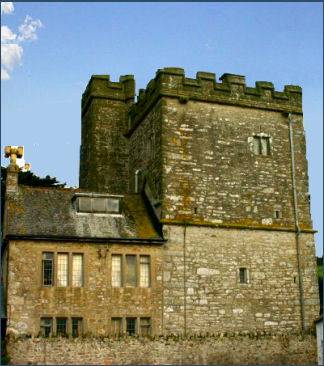Pengersick Castle
OS grid ref:-
 Situated at Praa Sands between Helston and Penzance, Pengersick Castle, which is reputed to be haunted, dates from the medieval era and features one of the few towers of its type preserved in Britain.
Situated at Praa Sands between Helston and Penzance, Pengersick Castle, which is reputed to be haunted, dates from the medieval era and features one of the few towers of its type preserved in Britain.
There is evidence to suggest that the site of Pengersick has been occupied since around the thirteenth century. In the fourteen century the castle was owned by Henry, Lord of Pengrysek. The building was then a courtyard castle with the tower sited in the south-east corner. A hall block stood at the east straddling the two courtyards. The outline of the extensive house and associated village settlement, chapel and garden has been identified through archaeological evidence.
This early building was almost entirely replaced by the present tower in around 1510 by William Worth and further extended a short time later by the Milliton family. The ground floor of the tower was well-defended. Numerous gun-loops cover the stair and entrance and a few defensive windows and there are additional gun-loops higher stories. There was possibly a parlour on the first floor and a solar on the second.
By the 1520s the castle had come in to the ownership of John Milliton, who became High Sheriff of Cornwall, the castle was improved around 1530 as a fortified manor house after the wreck of a valuable Portuguese ship. When John Milliton died in 1556, the estate was divided between the family and the castle gradually fell into disuse.
It would eventually became part of the estates of the influential Godolphin family. In the late twentieth Century the Prengersick Caastle came into the possession of Angela Evans. Before her death she set up the Pengersick Historic and Education Trust to manage and restore the castle. The grounds are being developed to display horticulture through the ages. The reconstruction of a Mediaeval Garden is now complete asd is a Tudor style Knot Garden.
The ghost of John Milliton is reputed to haunt the castle. Local legend tells that he attempted to poison his wife, but she switched their drinks. There are also rumours of devil worship and monks being murdered there. Research has proven some of these stories to be untrue, no monksmet their death there, although one wasattacked by Henry Pengersick, the supposed legend of the Black Dog is said to be a myth created by nineteenth century smugglers to scare away the curious.
One of the most colourful episodes in the history of Pengersick Castle was the wreck of the carrack "The St Anthony", the King of Portugal's treasure ship, which sank off Gunwalloe on 19th January 1527. Most of the ship's cargo, valued at £18,880, disappeared for ever. Although it could not be proven, John Milliton of Pengersick was strongly suspected to be the culprit. A diver explored of the site and recovered some 300 artifacts which he offered to the Pengersick Trust.
Historic Buildings in Cornwall